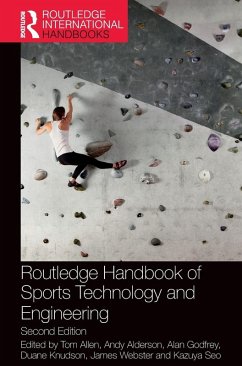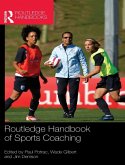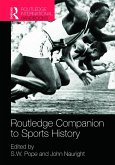Routledge Handbook of Sports Technology and Engineering
Herausgeber: Allen, Tom; Godfrey, Alan; Alderson, Andy
Routledge Handbook of Sports Technology and Engineering
Herausgeber: Allen, Tom; Godfrey, Alan; Alderson, Andy
- Gebundenes Buch
- Merkliste
- Auf die Merkliste
- Bewerten Bewerten
- Teilen
- Produkt teilen
- Produkterinnerung
- Produkterinnerung
Bringing together leading experts and scientists, the book emphasises the current understanding of the underlying mechanics associated with sport and physical activity, exercise, training, and athletic performance in relation to sports equipment, clothing and training and officiating technologies.
Andere Kunden interessierten sich auch für
![Routledge Handbook of Sports Coaching Routledge Handbook of Sports Coaching]() Routledge Handbook of Sports Coaching283,99 €
Routledge Handbook of Sports Coaching283,99 €![Routledge Handbook of Sports Performance Analysis Routledge Handbook of Sports Performance Analysis]() Routledge Handbook of Sports Performance Analysis276,99 €
Routledge Handbook of Sports Performance Analysis276,99 €![Routledge International Handbook of Sport Psychology Routledge International Handbook of Sport Psychology]() Routledge International Handbook of Sport Psychology273,99 €
Routledge International Handbook of Sport Psychology273,99 €![Routledge Handbook of Football Studies Routledge Handbook of Football Studies]() Routledge Handbook of Football Studies304,99 €
Routledge Handbook of Football Studies304,99 €![Routledge Companion to Sports History Routledge Companion to Sports History]() John Nauright / S. W. Pope (Hrsg.)Routledge Companion to Sports History262,99 €
John Nauright / S. W. Pope (Hrsg.)Routledge Companion to Sports History262,99 €![Routledge Handbook of Mobile Technology, Social Media and the Outdoors Routledge Handbook of Mobile Technology, Social Media and the Outdoors]() Routledge Handbook of Mobile Technology, Social Media and the Outdoors254,99 €
Routledge Handbook of Mobile Technology, Social Media and the Outdoors254,99 €![Routledge Handbook of Sport and Social Media Routledge Handbook of Sport and Social Media]() Routledge Handbook of Sport and Social Media284,99 €
Routledge Handbook of Sport and Social Media284,99 €-
-
-
Bringing together leading experts and scientists, the book emphasises the current understanding of the underlying mechanics associated with sport and physical activity, exercise, training, and athletic performance in relation to sports equipment, clothing and training and officiating technologies.
Produktdetails
- Produktdetails
- Verlag: Routledge
- 2. Auflage
- Seitenzahl: 574
- Erscheinungstermin: 29. September 2025
- Englisch
- Abmessung: 250mm x 175mm x 35mm
- Gewicht: 1157g
- ISBN-13: 9781032301426
- ISBN-10: 1032301422
- Artikelnr.: 71566441
- Herstellerkennzeichnung
- Libri GmbH
- Europaallee 1
- 36244 Bad Hersfeld
- gpsr@libri.de
- Verlag: Routledge
- 2. Auflage
- Seitenzahl: 574
- Erscheinungstermin: 29. September 2025
- Englisch
- Abmessung: 250mm x 175mm x 35mm
- Gewicht: 1157g
- ISBN-13: 9781032301426
- ISBN-10: 1032301422
- Artikelnr.: 71566441
- Herstellerkennzeichnung
- Libri GmbH
- Europaallee 1
- 36244 Bad Hersfeld
- gpsr@libri.de
Tom Allen is a Reader in the Department of Engineering, Manchester Metropolitan University, UK. He is a Fellow of the Institution of Mechanical Engineers (IMechE) and Editor¿in¿Chief of Sports Engineering. Andy Alderson is the Director of the Industry and Innovation Research Institute and a Professor of Smart Materials and Structures at Sheffield Hallam University, UK. He is a recognised world authority on auxetic (negative Poisson's ratio) materials. Alan Godfrey is an Associate Professor (Reader) in the Department of Computer and Information Sciences, Northumbria University, UK. He is a Deputy Editor of npj/Nature Digital Medicine, Editor of Maturitas, and Associate Editor of Journal of Neuro Engineering and Rehabilitation. He is a senior member of the IEEE (SMIEEE). Duane Knudson is Regents' Professor in the Department of Health and Human Performance, Texas State University, USA. He is a Fellow of the International Society of Biomechanics in Sports, the National Academy of Kinesiology, and the American College of Sports Medicine. James Webster leads a footwear materials innovation team within the Nike Exploration Team, Nike, USA. He is on the Editorial Board of Proceedings of the Institution of Mechanical Engineers, Part P: Journal of Sports Engineering and Technology. Kazuya Seo is a Professor at Kogakuin University, Japan, and currently serves as Chair of the Sports Engineering and Human Dynamics Division of the Japan Society of Mechanical Engineers (JSME). He is a Fellow of both the International Sports Engineering Association (ISEA) and JSME.
Part I: Sports mechanics. 1. Introduction to sports mechanics. 2. Projectiles in sport. 3. Computational fluid dynamics applied in sport: Part 1 - Capabilities and considerations. 4. Computational fluid dynamics applied in sport: Part 2 - Application in sport. 5. Soft materials in sport. 6. Finite element modelling in sport. 7. Musculoskeletal simulation in sport. Part II: Sports materials. 8. Introduction to sports materials. 9. Cellular solids for sports applications: Part 1 - Macroscopic properties and applications. 10. Cellular solids for sports applications: Part 2 - Micromechanics. 11. Fibre
reinforced composites for sports applications. 12. Advanced materials for board sports. 13. Textiles for sports clothing. Part III: Sports equipment design and manufacture. 14. Introduction to sports equipment design and manufacture. 15. Design and manufacturing of textile sports equipment. 16. 3D printing in sports. 17. Sustainable design and manufacturing of sports equipment. 18. Cricket gear and sustainability. 19. Design considerations for body padding in rugby. 20. Ergonomics and user
centered design of sports equipment. 21. The application of biological engineering to sports technology. 22. Design for athletes. Part IV: Sports biomechanics and human
equipment interaction. 23. Introduction to sports biomechanics and human
equipment interaction. 24. Biomechanical interactions with footwear. 25. How the golfer and driver interact to determine performance. 26. The quantified tennis athlete: The performer, the ball, the racquet and the technology. 27. Sports injury and trauma biomechanics: Surrogates, human data and modeling. 28. Biomechanics of athletes with impairment and adaptive equipment. Part V: Field testing, sensors and instrumentation for the digital athlete. 29. Introduction to field testing, sensors and instrumentation for the digital athlete. 30. Longitudinal assessment in sport: Injury and performance assessment. 31. Passive sensing in sport. 32. Inertial sensing in sports: Application and technical considerations. 33. Artificial intelligence approaches in sport. 34. Interoperable digital measurement and modelling to optimise tennis racket design: A case study. 35. Big data in sport: Case studies in football and tennis.
reinforced composites for sports applications. 12. Advanced materials for board sports. 13. Textiles for sports clothing. Part III: Sports equipment design and manufacture. 14. Introduction to sports equipment design and manufacture. 15. Design and manufacturing of textile sports equipment. 16. 3D printing in sports. 17. Sustainable design and manufacturing of sports equipment. 18. Cricket gear and sustainability. 19. Design considerations for body padding in rugby. 20. Ergonomics and user
centered design of sports equipment. 21. The application of biological engineering to sports technology. 22. Design for athletes. Part IV: Sports biomechanics and human
equipment interaction. 23. Introduction to sports biomechanics and human
equipment interaction. 24. Biomechanical interactions with footwear. 25. How the golfer and driver interact to determine performance. 26. The quantified tennis athlete: The performer, the ball, the racquet and the technology. 27. Sports injury and trauma biomechanics: Surrogates, human data and modeling. 28. Biomechanics of athletes with impairment and adaptive equipment. Part V: Field testing, sensors and instrumentation for the digital athlete. 29. Introduction to field testing, sensors and instrumentation for the digital athlete. 30. Longitudinal assessment in sport: Injury and performance assessment. 31. Passive sensing in sport. 32. Inertial sensing in sports: Application and technical considerations. 33. Artificial intelligence approaches in sport. 34. Interoperable digital measurement and modelling to optimise tennis racket design: A case study. 35. Big data in sport: Case studies in football and tennis.
Part I: Sports mechanics. 1. Introduction to sports mechanics. 2. Projectiles in sport. 3. Computational fluid dynamics applied in sport: Part 1 - Capabilities and considerations. 4. Computational fluid dynamics applied in sport: Part 2 - Application in sport. 5. Soft materials in sport. 6. Finite element modelling in sport. 7. Musculoskeletal simulation in sport. Part II: Sports materials. 8. Introduction to sports materials. 9. Cellular solids for sports applications: Part 1 - Macroscopic properties and applications. 10. Cellular solids for sports applications: Part 2 - Micromechanics. 11. Fibre
reinforced composites for sports applications. 12. Advanced materials for board sports. 13. Textiles for sports clothing. Part III: Sports equipment design and manufacture. 14. Introduction to sports equipment design and manufacture. 15. Design and manufacturing of textile sports equipment. 16. 3D printing in sports. 17. Sustainable design and manufacturing of sports equipment. 18. Cricket gear and sustainability. 19. Design considerations for body padding in rugby. 20. Ergonomics and user
centered design of sports equipment. 21. The application of biological engineering to sports technology. 22. Design for athletes. Part IV: Sports biomechanics and human
equipment interaction. 23. Introduction to sports biomechanics and human
equipment interaction. 24. Biomechanical interactions with footwear. 25. How the golfer and driver interact to determine performance. 26. The quantified tennis athlete: The performer, the ball, the racquet and the technology. 27. Sports injury and trauma biomechanics: Surrogates, human data and modeling. 28. Biomechanics of athletes with impairment and adaptive equipment. Part V: Field testing, sensors and instrumentation for the digital athlete. 29. Introduction to field testing, sensors and instrumentation for the digital athlete. 30. Longitudinal assessment in sport: Injury and performance assessment. 31. Passive sensing in sport. 32. Inertial sensing in sports: Application and technical considerations. 33. Artificial intelligence approaches in sport. 34. Interoperable digital measurement and modelling to optimise tennis racket design: A case study. 35. Big data in sport: Case studies in football and tennis.
reinforced composites for sports applications. 12. Advanced materials for board sports. 13. Textiles for sports clothing. Part III: Sports equipment design and manufacture. 14. Introduction to sports equipment design and manufacture. 15. Design and manufacturing of textile sports equipment. 16. 3D printing in sports. 17. Sustainable design and manufacturing of sports equipment. 18. Cricket gear and sustainability. 19. Design considerations for body padding in rugby. 20. Ergonomics and user
centered design of sports equipment. 21. The application of biological engineering to sports technology. 22. Design for athletes. Part IV: Sports biomechanics and human
equipment interaction. 23. Introduction to sports biomechanics and human
equipment interaction. 24. Biomechanical interactions with footwear. 25. How the golfer and driver interact to determine performance. 26. The quantified tennis athlete: The performer, the ball, the racquet and the technology. 27. Sports injury and trauma biomechanics: Surrogates, human data and modeling. 28. Biomechanics of athletes with impairment and adaptive equipment. Part V: Field testing, sensors and instrumentation for the digital athlete. 29. Introduction to field testing, sensors and instrumentation for the digital athlete. 30. Longitudinal assessment in sport: Injury and performance assessment. 31. Passive sensing in sport. 32. Inertial sensing in sports: Application and technical considerations. 33. Artificial intelligence approaches in sport. 34. Interoperable digital measurement and modelling to optimise tennis racket design: A case study. 35. Big data in sport: Case studies in football and tennis.








